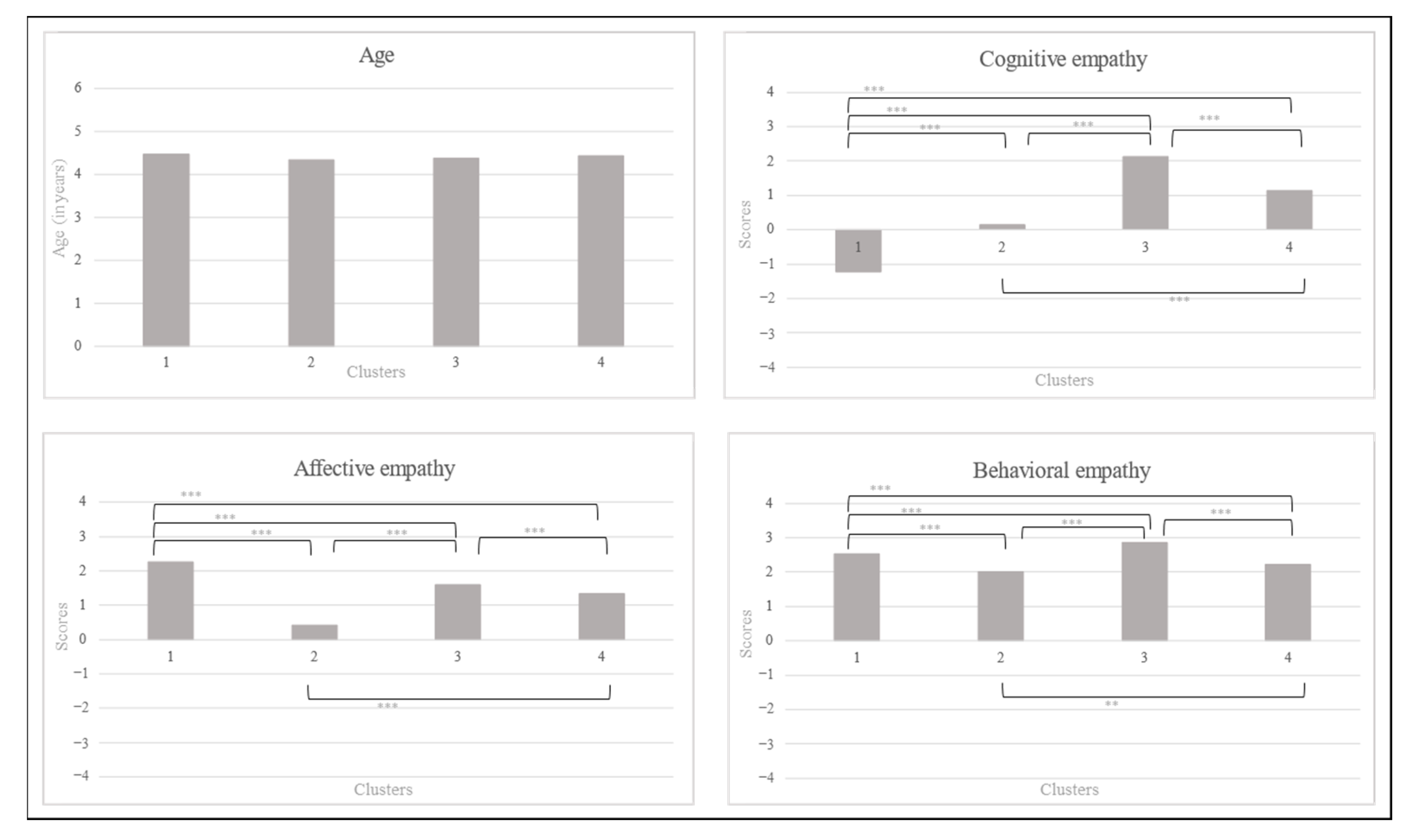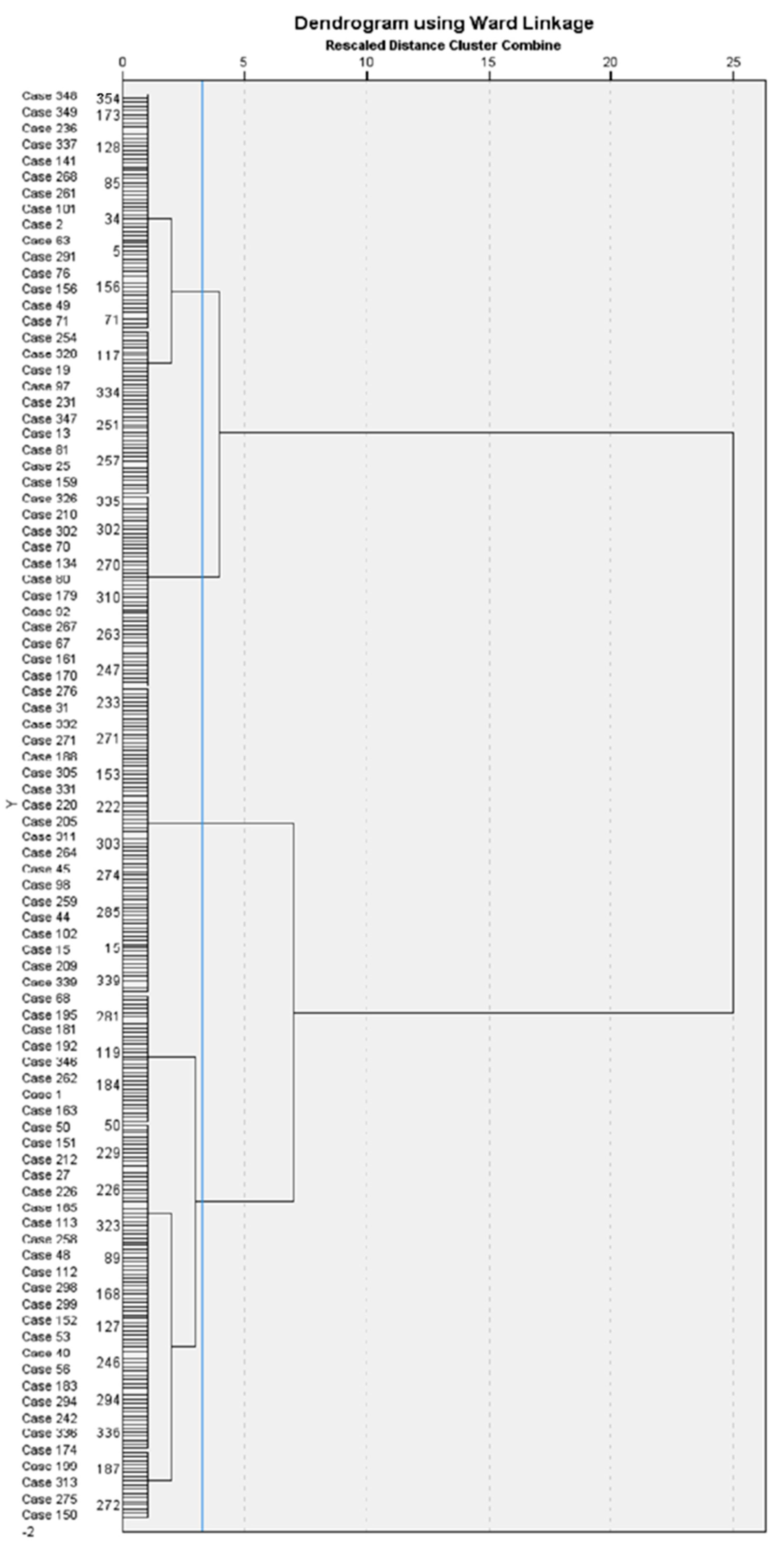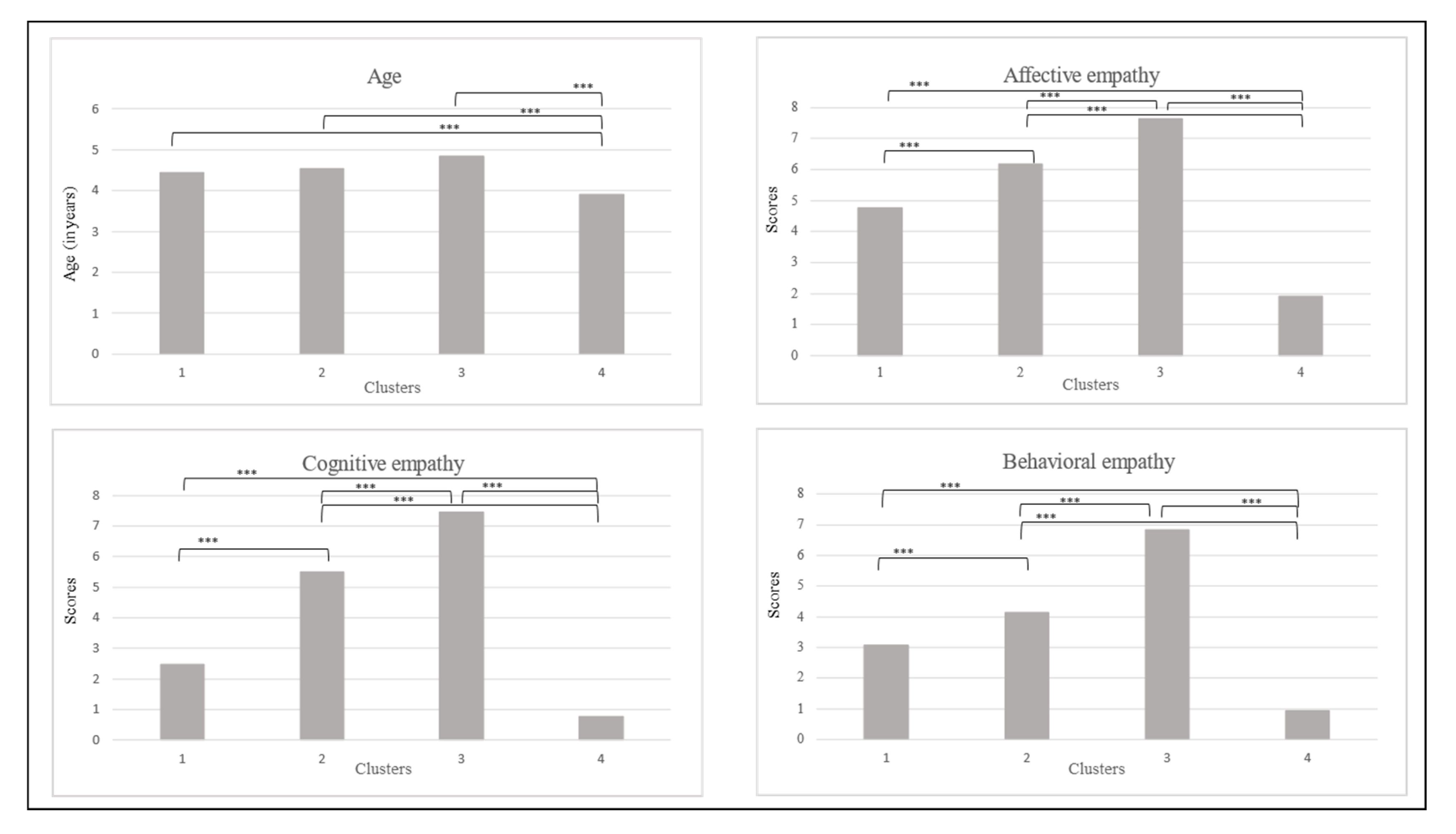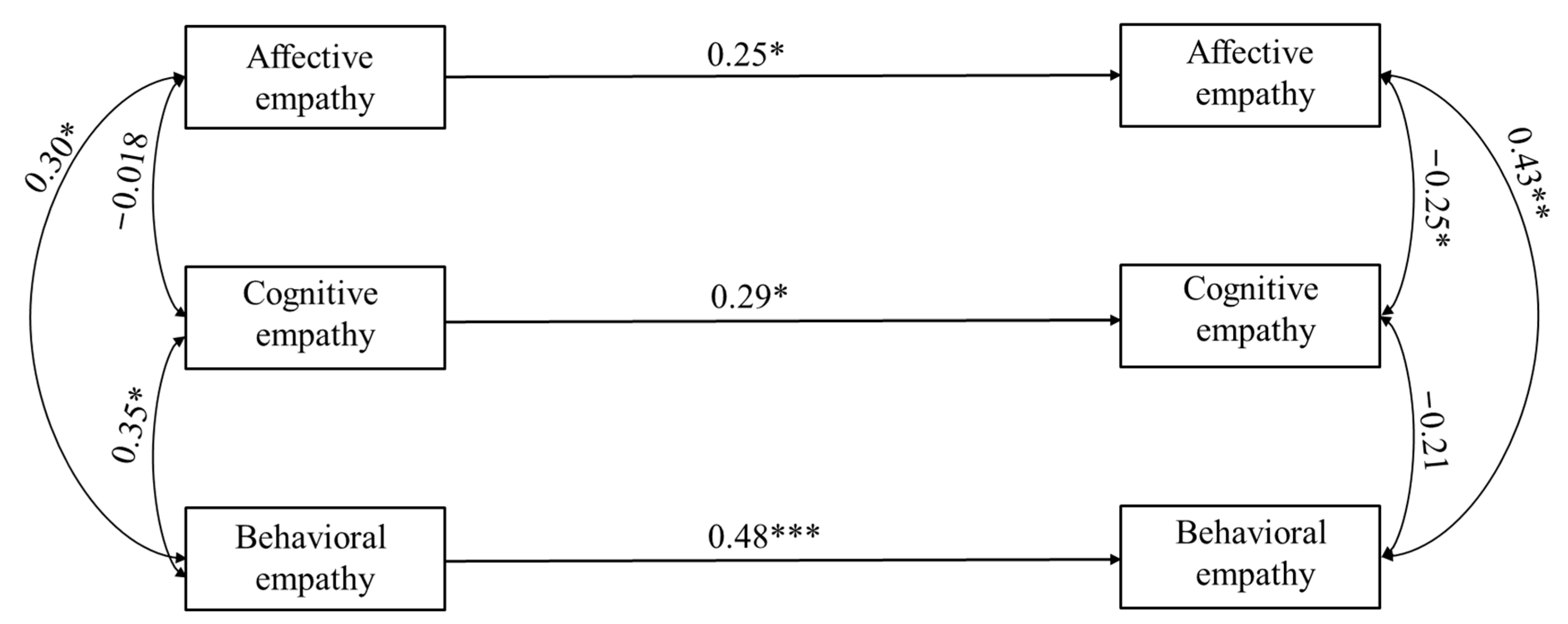Empathy in Preschoolers: Exploring Profiles and Age- and Gender-Related Differences
Abstract
:1. Introduction
2. Study 1
Objectives
3. Method
3.1. Participants
3.2. Measures
3.2.1. Griffith Empathy Measure
3.2.2. Prosocial Actions Subscale of the Empathy Questionnaire
3.2.3. Empathy Task
3.3. Procedure
4. Data Analysis
5. Results
5.1. Preliminary Analysis
5.2. Empathy Differences Depending on Gender and Age
5.3. Hierarchical Cluster Analysis of Cases
6. Study 2
6.1. Objective
6.2. Participants
6.3. Measures
6.4. Procedure
7. Data Analysis
8. Results
8.1. Preliminary Analysis
8.2. Cross-Lagged Analysis
9. Discussion
10. Conclusions
Author Contributions
Funding
Institutional Review Board Statement
Informed Consent Statement
Data Availability Statement
Conflicts of Interest
References
- Eisenberg, N.; Fabes, R.A.; Spinrad, T.L. Prosocial Development, 6th ed.; Eisenberg, N., Damon, W., Lerner, R.M., Eds.; John Wiley & Sons Inc.: Hoboken, NJ, USA, 2006; Chapter xxiv; pp. 646–718. [Google Scholar]
- Decety, J.; Holvoet, C. The development of empathy in infancy. L’Année Psychol. 2021, 121, 239–273. [Google Scholar] [CrossRef]
- Heyes, C. Empathy is not in our genes. Neurosci. Biobehav. Rev. 2018, 95, 499–507. [Google Scholar] [CrossRef] [PubMed]
- Dadds, M.R.; Hunter, K.; Hawes, D.J.; Frost, A.D.J.; Vassallo, S.; Bunn, P.; Merz, S.; El Masry, Y. A measure of cognitive and affective empathy in children using parent ratings. Child Psychiatry Hum. Dev. 2008, 39, 111–122. [Google Scholar] [CrossRef] [PubMed]
- Teherani, A.; Hauer, K.E.; O’Sullivan, P. Can simulations measure empathy? Considerations on how to assess behavioral empathy via simulations. Patient Educ. Couns. 2008, 71, 148–152. [Google Scholar] [CrossRef] [PubMed]
- Brown, M.M.; Thibodeau, R.B.; Pierucci, J.M.; Gilpin, A.T. Supporting the development of empathy: The role of theory of mind and fantasy orientation. Soc. Dev. 2017, 26, 951–964. [Google Scholar] [CrossRef]
- Farina, E.; Belacchi, C. The relationship between emotional competence and hostile/prosocial behavior in Albanian preschoolers: An exploratory study. Sch. Psychol. Int. 2014, 35, 475–484. [Google Scholar] [CrossRef]
- Tully, E.C.; Donohue, M.R. Empathic responses to mother’s emotions predict internalizing problems in children of depressed mothers. Child Psychiatry Hum. Dev. 2017, 48, 94–106. [Google Scholar] [CrossRef] [PubMed]
- Auyeung, B.; Wheelwright, S.; Allison, C.; Atkinson, M.; Samarawickrema, N.; Baron-Cohen, S. The children’s empathy quotient and systemizing quotient: Sex differences in typical development and in autism spectrum conditions. J. Autism Dev. Disord. 2009, 39, 1509–1521. [Google Scholar] [CrossRef]
- Strayer, J.; Roberts, W. Empathy and observed anger and aggression in five-year-olds. Soc. Dev. 2004, 13, 1–13. [Google Scholar] [CrossRef]
- Belacchi, C.; Farina, E. Feeling and thinking of others: Affective and cognitive empathy and emotion comprehension in prosocial/hostile preschoolers. Aggress. Behav. 2012, 38, 150–165. [Google Scholar] [CrossRef]
- Strauss, C. Is Empathy Gendered and, If So, Why? An Approach from Feminist Psychological Anthropology. Ethos 2004, 32, 432–457. [Google Scholar] [CrossRef]
- Howe, A.; Pit-ten Cate, I.M.; Brown, A.; Hadwin, J.A. Empathy in preschool children: The development of the Southampton Test of Empathy for Preschoolers (STEP). Psychol. Assess. 2008, 20, 305–309. [Google Scholar] [CrossRef]
- Simon, P.; Nader-Grosbois, N. Preschoolers’ Empathy Profiles and Their Social Adjustment. Front. Psychol. 2021, 12, 782500. [Google Scholar] [CrossRef] [PubMed]
- Bensalah, L.; Caillies, S.; Anduze, M. Links among cognitive empathy, theory of mind, and affective perspective taking by young children. J. Genet. Psychol. Res. Theory Hum. Dev. 2016, 177, 17–31. [Google Scholar] [CrossRef] [PubMed]
- Hoffman, M.L. The contribution of empathy to justice and moral judgment. In Empathy and Its Development; Cambridge University Press: New York, NY, USA, 1987; pp. 47–80. [Google Scholar]
- Ford, R.M.; Lobao, S.N.; Macaulay, C.; Herdman, L.M. Empathy, theory of mind, and individual differences in the appropriation bias among 4- and 5-year-olds. J. Exp. Child Psychol. 2011, 110, 626–646. [Google Scholar] [CrossRef] [PubMed]
- Roberts, W.; Strayer, J. Empathy, Emotional Expressiveness, and Prosocial Behavior. Child Dev. 1996, 67, 449–470. [Google Scholar] [CrossRef]
- Simon, P.; Houssa, M.; Barbot, B.; Nader-Grosbois, N. Adaptation and Validation of the French version of Empathy Questionnaire (EmQue) in preschoolers aged from 2 to 6 years. Soc. Dev. 2023; under review. [Google Scholar]
- Nader-Grosbois, N.; Simon, P. Adaptation and Validation of a French Version of the Griffith Empathy Measure. J. Psychopathol. Behav. Assess. 2023. [Google Scholar] [CrossRef]
- Brink, T.T.; Urton, K.; Held, D.; Kirilina, E.; Hofmann, M.J.; Klann-Delius, G.; Jacobs, A.M.; Kuchinke, L. The Role of Orbitofrontal Cortex in Processing Empathy Stories in 4- to 8-Year-Old Children. Front. Psychol. 2011, 2, 80. [Google Scholar] [CrossRef] [PubMed]
- Decety, J.; Lewis, K.L.; Cowell, J.M. Specific electrophysiological components disentangle affective sharing and empathic concern in psychopathy. J Neurophysiol. 2015, 114, 493–504. [Google Scholar] [CrossRef] [PubMed]
- Schwenck, C.; Göhle, B.; Hauf, J.; Warnke, A.; Freitag, C.M.; Schneider, W. Cognitive and emotional empathy in typically developing children: The influence of age, gender, and intelligence. Eur. J. Dev. Psychol. 2014, 11, 63–76. [Google Scholar] [CrossRef]
- Catherine, N.L.A.; Schonert-Reichl, K.A. Children’s perceptions and comforting strategies to infant crying: Relations to age, sex, and empathy-related responding. Br. J. Dev. Psychol. 2011, 29, 524–551. [Google Scholar] [CrossRef] [PubMed]
- Liew, J.; Eisenberg, N.; Spinrad, T.L.; Eggum, N.D.; Haugen, R.G.; Kupfer, A.; Reiser, M.R.; Smith, C.L.; Lemery-Chalfant, K.; Baham, M.E. Physiological regulation and fearfulness as predictors of young children’s empathy-related reactions. Soc. Dev. 2011, 20, 111–134. [Google Scholar] [CrossRef] [PubMed]
- Anastassiou-Hadjicharalambous, X.; Warden, D. Convergence between physiological, facial and verbal self-report measures of affective empathy in children. Infant Child Dev. Int. J. Res. Pract. 2007, 16, 237–254. [Google Scholar] [CrossRef]
- Noten, M.M.P.G.; Van Der Heijden, K.B.; Huijbregts, S.C.J.; Van Goozen, S.H.M.; Swaab, H. Infant emotional responses to challenge predict empathic behavior in toddlerhood. Dev. Psychobiol. 2020, 62, 454–470. [Google Scholar] [CrossRef] [PubMed]
- Reid, C.; Davis, H.; Horlin, C.; Anderson, M.; Baughman, N.; Campbell, C. The Kids’ Empathic Development Scale (KEDS): A multi-dimensional measure of empathy in primary school-aged children. Br. J. Dev. Psychol. 2013, 31, 231–256. [Google Scholar] [CrossRef] [PubMed]
- Eisenberg, N.; Fabes, R.A. Empathy: Conceptualization, measurement, and relation to prosocial behavior. Motiv. Emot. 1990, 14, 131–149. [Google Scholar] [CrossRef]
- Bulgarelli, C.; Jones, E.J.H. The typical and atypical development of empathy: How big is the gap from lab to field? JCPP Adv. 2023, 3, e12136. [Google Scholar] [CrossRef]
- Rieffe, C.; Ketelaar, L.; Wiefferink, C.H. Assessing empathy in young children: Construction and validation of an Empathy Questionnaire (EmQue). Personal. Individ. Differ. 2010, 49, 362–367. [Google Scholar] [CrossRef]
- Kline, R.B. Principles and Practice of Structural Equation Modeling; Guilford Publications: New York, NY, USA, 2023. [Google Scholar]
- Lucas-Molina, B.; Sarmento, R.; Quintanilla, L.; Giménez-Dasí, M. The Spanish Version of the Empathy Questionnaire (EmQue): Evidence for Longitudinal Measurement Invariance and Relationship With Emotional Regulation. Early Educ. Dev. 2018, 29, 467–476. [Google Scholar] [CrossRef]
- Hughes, R.; Tingle, B.A.; Sawin, D.B. Development of Empathic Understanding in Children. Child Dev. 1981, 52, 122–128. [Google Scholar] [CrossRef]
- Strayer, J.; Roberts, W. Facial and verbal measures of children’s emotions and empathy. Int. J. Behav. Dev. 1997, 20, 627–649. [Google Scholar] [CrossRef]
- Madley-Dowd, P.; Hughes, R.; Tilling, K.; Heron, J. The proportion of missing data should not be used to guide decisions on multiple imputation. J. Clin. Epidemiol. 2019, 110, 63–73. [Google Scholar] [CrossRef]





| M (SD) | % | |
|---|---|---|
| Mothers’ education level | 5.09 (1.16) | |
| Primary school | 2.4% | |
| Vocational qualification | 9.1% | |
| High school qualification | 14.0% | |
| Bachelor’s degree | 31.1% | |
| Master’s degree | 39.5% | |
| Ph.D. | 3.9% | |
| Fathers’ education level | 4.68 (1.31) | |
| Primary school | 3.2% | |
| Vocational qualification | 21.1% | |
| High school qualification | 18.2% | |
| Bachelor’s degree | 21.1% | |
| Master’s degree | 34.6% | |
| Ph.D. | 1.8% | |
| Family income | 8.01 (2.53) |
| Total | Boys | Girls | |||||||
|---|---|---|---|---|---|---|---|---|---|
| M (SD) | Skewness | Kurtosis | M (SD) | Skewness | Kurtosis | M (SD) | Skewness | Kurtosis | |
| N | 354 | 159 | 205 | ||||||
| Chronological age (in years) | 4.40 (1.02) | 0.069 | −1.140 | 4.36 (1.025) | 0.177 | −1.112 | 4.43 (1.02) | −0.014 | −1.141 |
| Hetero-reported measure | |||||||||
| Affective empathy (max = 4) | 1.21 (.88) | −0.028 | 0.98 | 1.18 (.97) | −0.434 | 1.379 | 1.22 (0.81) | −0.064 | 0.100 |
| Cognitive empathy (max = 4) | 1.00 (1.24) | −0.435 | 0.527 | 1.08 (1.29) | −0.334 | 0.104 | 0.93 (1.20) | −0.565 | 0.947 |
| Prosocial actions (max = 16) | 2.34 (0.49) | 0.076 | 0.627 | 2.33 (0.49) | 0.065 | 0.544 | 2.36 (0.50) | 0.081 | 0.725 |
| Performance-based measure | |||||||||
| Affective empathy (max = 8) | 4.93 (2.11) | −0.295 | −0.693 | 4.68 (2.09) | −0.052 | −1.007 | 5.12 (2.11) | −0.492 | −0.314 |
| Cognitive empathy (max = 8) | 3.63 (2.55) | 0.126 | −1.133 | 3.45 (2.52) | 0.253 | −1.111 | 3.78 (2.57) | 0.029 | −1.116 |
| Behavioral empathy (max = 8) | 3.43 (2.34) | 0.076 | 0.627 | 3.26 (2.40) | 0.263 | −1.096 | 3.57 (2.31) | 0.164 | −0.782 |
| Age | Affective Empathy—GEM-vf | Cognitive Empathy—GEM-vf | Prosocial Actions—EmQue-vf | Affective Empathy—Task | Cognitive Empathy—Task | |
|---|---|---|---|---|---|---|
| Affective empathy—GEM-vf | 0.162 ** | |||||
| Cognitive empathy—GEM-vf | 0.067 | 0.172 *** | ||||
| Prosocial actions—GEM-vf | 0.180 *** | 0.330 *** | 0.164 * | |||
| Affective empathy—Task | 0.221 *** | 0.039 | 0.011 | 0.095 | ||
| Cognitive empathy—Task | 0.342 *** | 0.043 | −0.059 | 0.060 | 0.744 *** | |
| Behavioral empathy—Task | 0.299 *** | −0.038 | 0.047 | 0.059 | 0.600 *** | 0.668 *** |
| Cluster 1 | Cluster 2 | Cluster 3 | Cluster 4 | |||
|---|---|---|---|---|---|---|
| M (SD) | M (SD) | M (SD) | M (SD) | F | ηp2 | |
| N | 21 | 80 | 86 | 167 | ||
| Chronological age | 4.48 (1.03) | 4.35 (1.057) | 4.38 (0.984) | 4.44 (1.044) | 0.175 | 0.001 |
| Empathy | ||||||
| GEM-vf—Affective empathy (max = 4) | 2.24 (0.48) | 0.42 (0.62) | 1.59 (0.84) | 1.32 (0.48) | 74.688 *** | 0.390 |
| GEM-vf—Cognitive empathy (max = 4) | −1.21 (0.91) | 0.13 (1.27) | 2.12 (0.83) | 1.13 (0.58) | 122.136 *** | 0.511 |
| EmQue-vf—Prosocial actions (max = 16) | 2.53 (0.40) | 2.02 (0.48) | 2.85 (0.38) | 2.23 (0.30) | 78.875 *** | 0.403 |
| Cluster 1 | Cluster 2 | Cluster 3 | Cluster 4 | |||
|---|---|---|---|---|---|---|
| M (SD) | M (SD) | M (SD) | M (SD) | F | ηp2 | |
| N | 130 | 100 | 48 | 76 | ||
| Chronological age | 4.44 (1.11) | 4.53 (0.98) | 4.85 (0.74) | 3.91 (0.89) | 10.255 *** | 0.081 |
| Empathy | ||||||
| Empathy Task—Affective empathy (Max = 8) | 4.76 (1.27) | 6.18 (0.95) | 7.64 (0.52) | 1.90 (0.96) | 368.294 *** | 0.759 |
| Empathy Task—Cognitive empathy (Max = 8) | 2.48 (1.31) | 5.49 (1.12) | 7.45 (0.65) | 0.77 (0.88) | 502.029 *** | 0.811 |
| Empathy Task—Behavioral empathy (Max = 8) | 3.06 (1.80) | 4.13 (1.80) | 6.83 (0.87) | 0.94 (0.93) | 150.564 *** | 0.563 |
| Time 1 | Time 2 | |||||
|---|---|---|---|---|---|---|
| M (SD) | Skewness | Kurtosis | M (SD) | Skewness | Kurtosis | |
| N | 69 | 69 | ||||
| Chronological age (in years) | 3.90 (0.77) | 0.291 | −1.301 | 4.94 (0.80) | 0.111 | −1.428 |
| Hetero-reported measure | ||||||
| Affective empathy (max = 4) | 0.99 (1.01) | −0.109 | −0.242 | (0.97) | −0.434 | 1.379 |
| Cognitive empathy (max = 4) | 1.01 (1.20) | −0.551 | 0.140 | 1.08 (1.29) | −0.334 | 0.104 |
| Prosocial actions (max = 16) | 2.18 (0.61) | 0.257 | 0.500 | 2.33 (0.49) | 0.065 | 0.544 |
| Performance-based measure | ||||||
| Affective empathy (max = 8) | 4.63 (2.14) | −0.126 | −0.829 | 5.46 (0.1.93) | −0.271 | −0.654 |
| Cognitive empathy (max = 8) | 3.78 (2.41) | 0.172 | −1.046 | 4.5 (2.34) | −0.162 | −0.847 |
| Behavioral empathy (max = 8) | 3.58 (2.59) | 0.163 | −1.308 | 4.17 (2.53) | 0.360 | −0.018 |
| B | SE | β | z | p | R2 | |
|---|---|---|---|---|---|---|
| Affective empathy T2 | 0.08 | |||||
| Affective empathy T1 | 0.18 | 0.087 | 0.25 | 2.07 | 0.038 | |
| Cognitive empathy T1 | −0.055 | 0.077 | −0.089 | −0.72 | 0.472 | |
| Behavioral empathy T1 | 0.089 | 0.157 | 0.073 | 0.567 | 0.571 | |
| Cognitive empathy T2 | 0.10 | |||||
| Affective empathy T1 | −0.146 | 0.12 | −0.146 | −1.22 | 0.222 | |
| Cognitive empathy T1 | 0.256 | 0.106 | 0.293 | 2.41 | 0.016 | |
| Behavioral empathy T1 | −0.19 | 0.215 | −0.113 | −0.88 | 0.376 | |
| Behavioral empathy T2 | 0.19 | |||||
| Affective empathy T1 | −0.021 | 0.044 | −0.055 | −0.49 | 0.627 | |
| Cognitive empathy T1 | −0.026 | 0.039 | −0.07 | −0.68 | 0.497 | |
| Behavioral empathy T1 | 0.315 | 0.080 | 0.478 | 3.94 | 0.000 |
| Cov | SE | p | |
|---|---|---|---|
| Time 1 | |||
| Affective empathy and cognitive empathy | −0.015 | 0.103 | 0.883 |
| Affective empathy and behavioral empathy | 0.132 | 0.103 | 0.018 |
| Cognitive empathy and behavioral empathy | 0.176 | 0.065 | 0.007 |
| Time 2 | |||
| Affective empathy and cognitive empathy | −0.12 | 0.06 | 0.047 |
| Affective empathy and behavioral empathy | 0.078 | 0.023 | 0.001 |
| Cognitive empathy and behavioral empathy | −0052 | 0.030 | 0.085 |
Disclaimer/Publisher’s Note: The statements, opinions and data contained in all publications are solely those of the individual author(s) and contributor(s) and not of MDPI and/or the editor(s). MDPI and/or the editor(s) disclaim responsibility for any injury to people or property resulting from any ideas, methods, instructions or products referred to in the content. |
© 2023 by the authors. Licensee MDPI, Basel, Switzerland. This article is an open access article distributed under the terms and conditions of the Creative Commons Attribution (CC BY) license (https://creativecommons.org/licenses/by/4.0/).
Share and Cite
Simon, P.; Nader-Grosbois, N. Empathy in Preschoolers: Exploring Profiles and Age- and Gender-Related Differences. Children 2023, 10, 1869. https://doi.org/10.3390/children10121869
Simon P, Nader-Grosbois N. Empathy in Preschoolers: Exploring Profiles and Age- and Gender-Related Differences. Children. 2023; 10(12):1869. https://doi.org/10.3390/children10121869
Chicago/Turabian StyleSimon, Poline, and Nathalie Nader-Grosbois. 2023. "Empathy in Preschoolers: Exploring Profiles and Age- and Gender-Related Differences" Children 10, no. 12: 1869. https://doi.org/10.3390/children10121869
APA StyleSimon, P., & Nader-Grosbois, N. (2023). Empathy in Preschoolers: Exploring Profiles and Age- and Gender-Related Differences. Children, 10(12), 1869. https://doi.org/10.3390/children10121869




